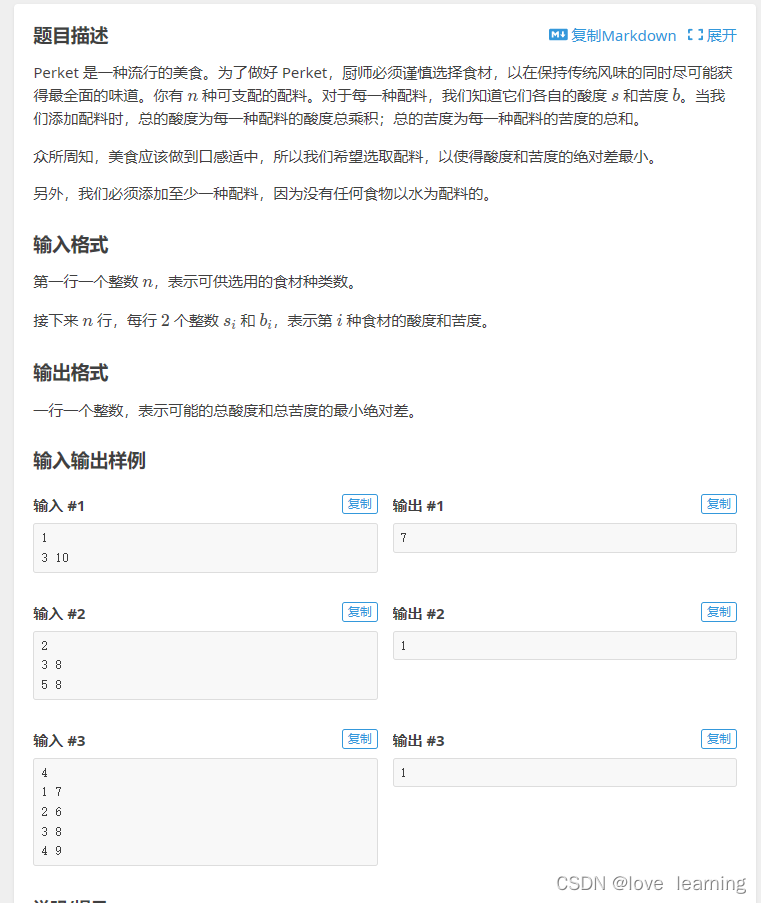今天学了队列、二叉树的序列遍历,dfs(深搜),AC的几道题目。
队列;一种先进先出的线性表,它与栈不同的是,栈是允许在一端插入或者删除的线性表,而队列是一端插入另一端删除的线性表;
队列的一些基本操作:
#include "iostream"
using namespace std;
#define maxsize 10
typedef struct {
int data[maxsize]; //用静态数组存放队列元素
int front, rear; //队头指针和队尾指针
}sqQueue;
void initQueue(sqQueue& Q) {
Q.front = Q.rear = 0; //初始化队头队尾指针指向0
}
bool QueueEmpty(sqQueue& Q) { //判断队列是否为空
if (Q.rear == Q.front) //队空条件
return true;
else return false;
}
bool EnQueue(sqQueue& Q, int x) { //入队
if ((Q.rear + 1) % maxsize==Q.front)//队列已满(队尾指针的下一个位置是队头,代价:牺牲一个存储单元)因为再存入一个队头队尾就指在一起了,和空队列会产生歧义
return false;
Q.data[Q.rear] = x; //将x插入队尾
Q.rear =(Q.rear + 1) % maxsize; //队尾指针加1取模
return true;
}
bool DeQueue(sqQueue& Q, int &x) { //出队
if (Q.front == Q.rear) //判断栈空
return false;
x = Q.data[Q.front];
Q.front = (Q.front + 1) % maxsize;
return true;
}
bool Gethead(sqQueue& Q, int& x) { //查找队头元素
if (Q.front == Q.rear)
return false;
x = Q.data[Q.front];
return true;
}
int main() { //只允许在一头进行插入,另一端进行删除(特点:先进先出)
int n,x;
sqQueue Q; //声明一个队列
initQueue(Q);
QueueEmpty(Q);
EnQueue(Q, 3);
DeQueue(Q, n);
Gethead(Q, x);
//队列元素个数:(rear+Maxsize-front)%Maxsize
}二叉树的三种序列遍历:先序、中序、后序;
先序就是先根结点再左再又,中序是左根右,后序是左右根;具体实现如下代码;
//二叉树的三种遍历方式
node{
int data;
node* left;
node* right;
}tree,a,c;
void solve1(node * t) {// 先序
if (t != NULL) {
cout << t->data;
solve1(t->left);
solve1(t->right);
}
}
void solve2(node* t) { // 中序
if (t != NULL) {
solve2(t->left);
cout << t->data;
solve2(t->right);
}
}
void solve3(node* t) { // 后序
if (t != NULL) {
solve3(t->left);
solve3(t->right);
cout << t->data;
}
}
int main() {
tree.data = 1;
a.data = 2;
c.data = 3;
tree.left = &a;
tree.right = &c;
a.left = a.right = NULL;
c.left = c.right = NULL;
solve1(&tree);
return 0;
} dfs(深度优先搜所): 一条路走到底,不撞南墙不回头。就是沿着一条路一直走,直到尽头就退回一个节点走另外一条路,一直递归重复这个过程直到所有的路都走完。
大概的一个模版是这样的:
int check(参数)
{
if(满足条件)
return 1;
return 0;
}
void dfs(int step)
{
判断边界
{
相应操作
}
尝试每一种可能
{
满足check条件
标记
继续下一步dfs(step+1)
恢复初始状态(回溯的时候要用到)
}
} 题目链接:https://www.luogu.com.cn/problem/P1443
题解:首先你要知道马是怎么走到,然后将数组全部赋值为-1,使用结构体队列模型,遍历马的八种走法,然后判断要是这个点马可以走到就把这个点放入队列里面。
AC代码:
#include <iostream>
#include <string>
#include <cmath>
#include <iomanip>
#include <algorithm>
#include <stack>
using namespace std;
using ll = long long;
#define up(h,n) for(int i=h;i<=n;i++)
#define down(h,n) for(int i=h;i>=n;i--)
#define wh(x) while(x--)
#define node struct node
#define ios ios::sync_with_stdio(false)
constexpr int N = 2000005;
constexpr int mod = 1e9 + 7;
typedef int SElemType;
node{
int x;
int y;
int num;//步数
}que[160005]; //创建队列
const int next1[8][2] = { {2, 1}, {1, 2}, {-2, -1}, {-1, -2}, {2, -1}, {-1, 2}, {-2, 1}, {1, -2} };
int a[405][405];
int main()
{
int tx, ty;
int n, m, x1, y1;
int head = 1, tail = 1;
cin >> n >> m >> x1 >> y1;
up(1, n) {//初始化数组为-1
for (int j = 1; j <= m; j++)
a[i][j] = -1;
}
que[tail].x = x1;
que[tail].y = y1;
que[tail].num = a[x1][y1] = 0;//插入队列数据,设置起点坐标,起点坐标标记为0
tail++;
while (head < tail) {
up(0, 7) {// 遍历马的八种情况
tx = que[head].x + next1[i][0];
ty = que[head].y + next1[i][1];//马下一个坐标
if (tx<1 || tx>n || ty<1 || ty>m) continue;//判断是否越界
if (a[tx][ty] == -1) {
que[tail].x = tx;
que[tail].y = ty;
que[tail].num = a[tx][ty] = que[head].num + 1;//插入队列数据
tail++;
}
}
head++;
}
up(1, n) {
for (int j = 1; j <= m; j++) {
cout << left << setw(5) << a[i][j];
}
cout << '\n';
}
return 0;
}题目链接:https://www.luogu.com.cn/problem/P2392

题解:用dfs深搜把每一课科目的习题所花的时间分给左脑和右脑都试一下,然后找出最小值。
AC代码:
#include <iostream>
#include <string>
#include <cmath>
#include <iomanip>
#include <algorithm>
#include <stack>
using namespace std;
using ll = long long;
#define up(h,n) for(int i=h;i<=n;i++)
#define down(h,n) for(int i=h;i>=n;i--)
#define wh(x) while(x--)
#define node struct node
#define ios ios::sync_with_stdio(false)
constexpr int N = 18;
constexpr int mod = 1e9 + 7;
typedef int SElemType;
int a[4], s[4][65];
int sum = 0, left1 = 0, right1 = 0,min1=0;
void dfs(int i, int j)
{
if (j >= a[i]) {
min1 = min(min1, max(left1, right1));//这一科已经计算完,寻找最小值两边大佬使用的最大
return; //值去和最小值比较,找出最小值
}
left1 += s[i][j];
dfs(i, j + 1);
left1 -= s[i][j];
right1 += s[i][j];
dfs(i, j + 1);
right1 -= s[i][j];// 这一部分主要是遍历科目的题集分给左脑和右脑都试一下;
return;
}
int main()
{
up(0, 3) {
cin >> a[i];
}
up(0, 3) {
for (int j = 0; j < a[i]; j++) {
cin >> s[i][j];
}
}
up(0, 3) {
left1 = 0, right1 = 0;
min1 = 99999;//每科都得从新找最小,所以每次得从新赋值
dfs(i, 0);
sum += min1;
}
cout << sum;
return 0;
}题目链接:https://www.luogu.com.cn/problem/P2404

题解:这个题还是比较简单,首先从1开始慢慢往后面深搜,每一次都加上,要是等于n就输出即可
AC代码:
#include <iostream>
#include <string>
#include <cmath>
#include <iomanip>
#include <algorithm>
#include <stack>
using namespace std;
using ll = long long;
#define up(h,n) for(int i=h;i<=n;i++)
#define down(h,n) for(int i=h;i>=n;i--)
#define wh(x) while(x--)
#define node struct node
#define ios ios::sync_with_stdio(false)
constexpr int N = 18;
constexpr int mod = 1e9 + 7;
typedef int SElemType;
//洛谷 p2404 自然数的拆分问题
int a[9], n;
void dfs(int s, int m, int k) { //s为多少个数 m为开始的数 k为和
if (k == n) { // 判断如果相等就输出
up(1, s - 2) {
cout << a[i] << '+';
}
cout << a[s - 1] << '\n';
return;
}
if (k > n) return;
up(m, n - 1) {
a[s] = i;
dfs(s + 1, i, k + i); // 继续往下搜
a[s] = 0; //回溯
}
return;
}
int main()
{
cin >> n;
dfs(1, 1, 0);
}题目链接:https://www.luogu.com.cn/problem/P2036

题解:这一题的话,只需对选取食材和不选取食材两种情况进行dfs然后每次找最小值即可;
AC代码:
#include <iostream>
#include <string>
#include <cmath>
#include <iomanip>
#include <algorithm>
#include <stack>
using namespace std;
using ll = long long;
#define up(h,n) for(int i=h;i<=n;i++)
#define down(h,n) for(int i=h;i>=n;i--)
#define wh(x) while(x--)
#define node struct node
#define ios ios::sync_with_stdio(false)
constexpr int N = 18;
constexpr int mod = 1e9 + 7;
typedef int SElemType;
int n,min1=99999;
int a[N][N];
void dfs(int i, int x, int y) {
if (i > n) {
if (y == 0) return ;
min1 = min(min1, abs(x - y));
return;
}
dfs(i + 1, x, y);//不选取食材
dfs(i + 1, x * a[i][0], y+a[i][1]);//选取食材
}
int main() {
cin >> n;
up(1, n) {
cin >> a[i][0] >> a[i][1];
}
dfs(1, 1, 0);
cout << min1;
return 0;
}






 本文介绍了队列的基本操作和二叉树的先序、中序、后序遍历,以及深度优先搜索(DFS)的概念和应用实例,通过解决实际编程题目展示了这些概念在解决问题中的运用。
本文介绍了队列的基本操作和二叉树的先序、中序、后序遍历,以及深度优先搜索(DFS)的概念和应用实例,通过解决实际编程题目展示了这些概念在解决问题中的运用。















 662
662











 被折叠的 条评论
为什么被折叠?
被折叠的 条评论
为什么被折叠?








